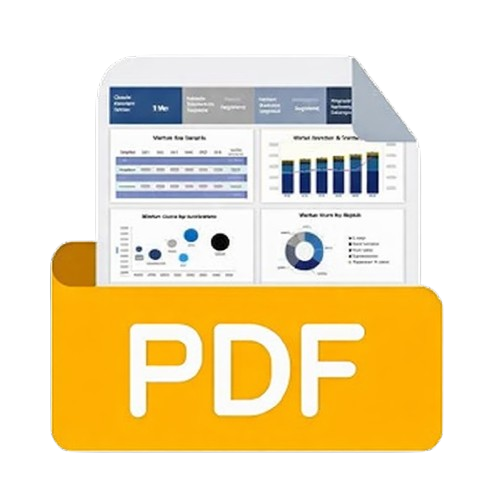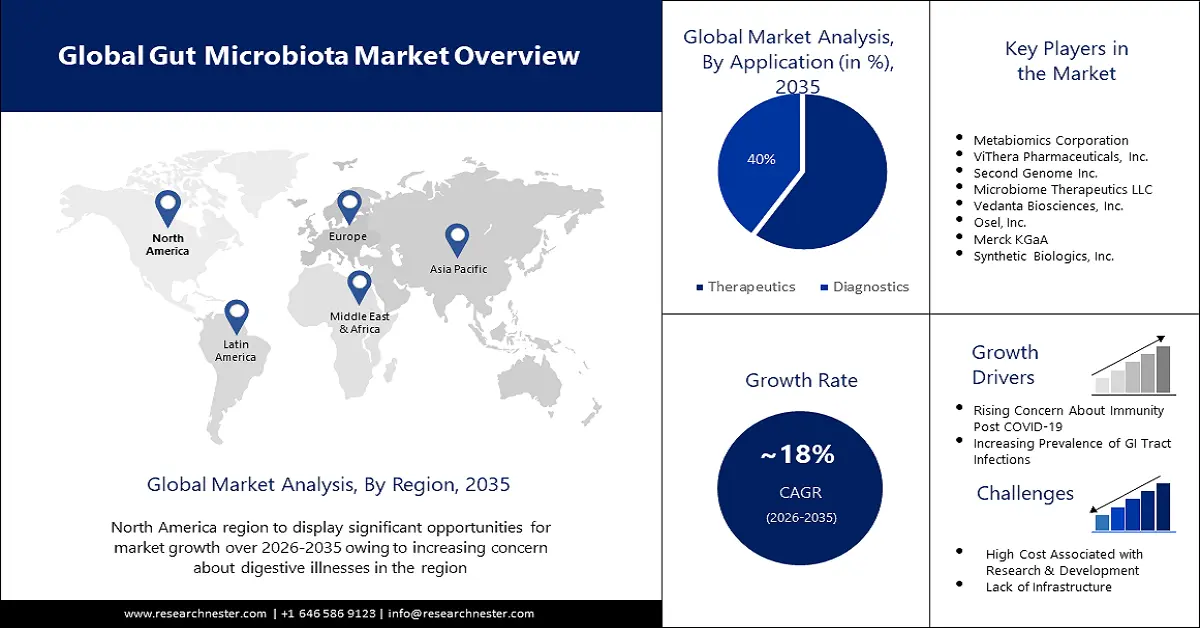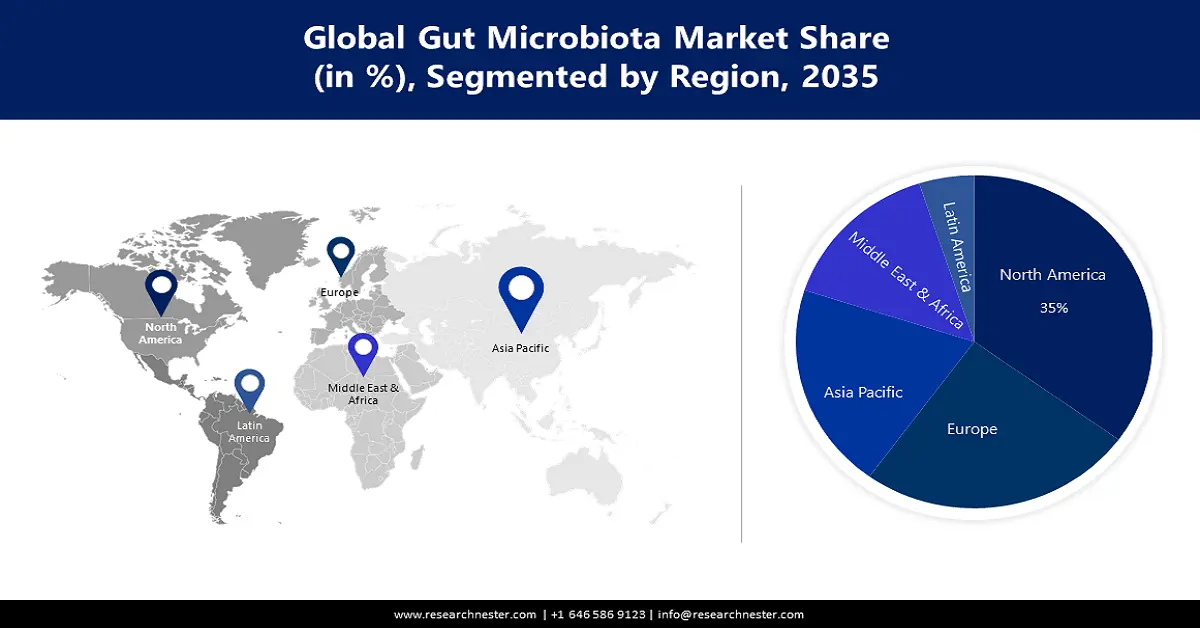
기간 한정 특별 할인 행사 | 장내 미생물군 시장 보고서 @ $2450
장내 미생물 시장 전망:
장내 미생물 시장 규모는 2025년 8억 6,040만 달러로 평가되었으며, 2035년에는 46억 6,000만 달러를 넘어설 것으로 예상되며, 2026년부터 2035년까지 예측 기간 동안 연평균 18.4% 이상 성장할 것으로 예상됩니다. 2026년에는 장내 미생물 시장 규모가 10억 달러로 추산됩니다.

시장 성장은 코로나19 이후 면역력이 약한 사람들이 팬데믹의 영향을 가장 많이 받았기 때문에 인간 면역 체계에 대한 관심이 높아진 데 기인합니다. 세계보건기구(WHO)에 따르면 2023년 3월 23 일 기준 전 세계적으로 코로나19 확진자는 7억 6,107만 1,826명이며, 이 중 6,879,677명이 사망했습니다. 또한, 장내 미생물총이 면역에 미치는 역할이 증가하고 장내 세균총 개선에 대한 연구가 활발해짐에 따라 시장 성장이 더욱 가속화될 것으로 예상됩니다.
이 외에도 장내 미생물총 시장 성장을 촉진하는 요인으로는 투자 급증, 그리고 인체 미생물 총 치료법을 한 단계 발전시키기 위한 주요 기업들의 협력 등이 꼽힙니다. 예를 들어, 바일란 대학교(Bar-Ilan University)의 새로운 연구에 따르면, 장내 미생물은 일반적으로 진단되는 시기보다 몇 달 빠른 임신 첫 3개월부터 임신성 당뇨병을 진단할 수 있을 것으로 예상됩니다. 전 세계적으로 임산부의 약 10%를 괴롭히는 임신성 당뇨병(GDM)에 대한 우려가 커지고 있어, 예상 기간 동안 시장 확장 가능성이 높아질 것으로 예상됩니다.
키 장내 미생물군 시장 통찰 요약:
지역별 주요 내용:
- 북미 장내 미생물 시장은 소화기 질환에 대한 우려 증가와 의료비 지출 증가로 인해 2035년까지 약 35%의 시장 점유율을 차지할 것으로 예상됩니다.
- 유럽 시장은 고령 인구 증가 및 만성 질환, 그리고 마이크로바이옴 치료 연구 개발로 인해 2035년까지 25%의 시장 점유율을 확보할 것으로 예상됩니다.
세그먼트 인사이트:
- 바이오제약 투자 증가와 코로나19 이후 바이오제약 매출 증가에 힘입어 장내 미생물총 시장의 치료 부문은 2035년까지 60%의 점유율을 차지할 것으로 예상됩니다.
- 장내 미생물총 시장의 감염 부문은 위장염 및 급성 위장관 감염 유병률 증가에 힘입어 2035년까지 45%의 점유율을 달성할 것으로 예상됩니다.
주요 성장 추세:
- 위장관(GI) 질환 유병률 증가
- 1형 및 2형 당뇨병 유병률 증가
주요 과제:
- 마이크로바이옴 진단 플랫폼 개발 관련 높은 비용
- 유리한 보험급여 시나리오 부족
주요 기업:Merck KGaA, Metabiomics Corporation, ViThera Pharmaceuticals, Inc., Second Genome Inc., Microbiome Therapeutics LLC, Vedanta Biosciences, Inc., Osel, Inc., Synthetic Biologics, Inc., Synlogic, 4D Pharma plc, Metabogen AB, Symbiotix Biotherapies, Inc.
글로벌 장내 미생물군 시장 예측 및 지역 전망:
시장 규모 및 성장 예측:
- 2025년 시장 규모: 8억 6,040만 달러
- 2026년 시장 규모: 10억 달러
- 예상 시장 규모: 2035년까지 46억 6천만 달러
- 성장 예측: 18.4% CAGR (2026-2035)
주요 지역 역학:
- 가장 큰 지역: 북미(2035년까지 35% 점유율)
- 가장 빠르게 성장하는 지역: 아시아 태평양
- 주요 국가: 미국, 중국, 일본, 독일, 영국
- 신흥국: 중국, 일본, 인도, 한국, 싱가포르
Last updated on : 8 September, 2025
장내 미생물 시장 성장 동인 및 과제:
성장 동력
위장관(GI) 질환 유병률 증가 - 장내 미생물은 방대하고 복잡한 미생물 군집으로, 인간의 건강에 여러모로 영향을 미칩니다. 장내 미생물은 인간의 영양소 흡수를 돕는 데 필수적입니다. 따라서 건강에 해로운 식품 섭취 증가로 인해 전 세계적으로 위장관 질환 유병률이 증가하고 있으며, 전 세계 중년층의 스트레스 수준도 급증함에 따라 시장 성장이 가속화될 것으로 예상됩니다. 미국에서는 과민성 대장 증후군 유병률이 11%에서 14% 사이로 추정되며, 향후 몇 년 동안 이 비율은 더욱 증가할 것으로 예상됩니다.
1형 및 2형 당뇨병의 유병률 증가 - 장내 세균 구성의 변화는 만성 저급 염증의 존재와 관련이 있는 것으로 알려져 있습니다. 이는 인슐린 저항성과 2형 당뇨병의 특징입니다. 전 세계적으로 2형 당뇨병의 유병률이 증가함에 따라 예측 기간 동안 시장 성장이 가속화될 것으로 예상됩니다. 연구에 따르면 3,700만 명이 넘는 미국인(10명 중 1명꼴)이 당뇨병을 앓고 있으며, 그중 약 90~95%가 2형 당뇨병을 앓고 있습니다.
의료비 지출 증가 – 최근 지출 데이터에 따르면 전 세계 의료비 지출은 지난 20년간 실질적으로 두 배 증가하여 2019년에는 8.5조 달러에 달했으며, GDP의 9.8%를 차지했습니다. 이는 2000년 8.5%에서 증가한 수치입니다. 어린이와 중년층 인구의 장내 미생물 다양성 저하에 대한 우려가 커지면서, 이 시장은 예측 기간 동안 성장할 것으로 예상됩니다.
어린이 설사 유병률 급증 – 세계보건기구(WHO) 보고서에 따르면, 설사는 5세 미만 어린이 사망 원인 중 두 번째로 높은 비율을 차지하며, 매년 약 50만 명의 5세 미만 어린이가 설사로 사망합니다. 또한, 전 세계적으로 매년 약 20억 명의 어린이가 설사성 질환을 앓고 있습니다.
장에는 유익균과 유해균이 모두 존재하기 때문에 유해균이 위장관으로 들어오면 감염이 발생합니다. 따라서 식중독을 비롯한 설사와 구토를 유발하는 기타 위장 질환을 예방하기 위한 연구 및 투자가 증가함에 따라 시장이 상당한 속도로 성장할 것으로 예상됩니다.
도전 과제
- 마이크로바이옴 진단 플랫폼 개발에 따른 높은 비용 - 마이크로바이옴 진단 분야의 연구개발 역량은 사용되는 플랫폼, 기술 및 인프라 시설에 크게 좌우됩니다. 이러한 시설은 인체 마이크로바이옴 및 장내 미생물총 연구에는 제한적이고 부족합니다. 결과적으로 이는 향후 시장 성장을 저해할 것으로 예상됩니다. 더욱이, 저소득 및 중소득 국가의 적절한 인프라 부족과 기술 보급률 저하는 시장 성장을 더욱 저해하고 있습니다.
- 유리한 환불 시나리오 부족
- 자격을 갖춘 전문가 및 지원 직원 부족
장내 미생물 시장 규모 및 예측:
| 보고서 속성 | 세부정보 |
|---|---|
|
기준 연도 |
2025 |
|
예측 기간 |
2026-2035 |
|
연평균 성장률 |
18.4% |
|
기준 연도 시장 규모(2025년) |
8억 6,040만 달러 |
|
예측 연도 시장 규모(2035년) |
46억 6천만 달러 |
|
지역 범위 |
|
장내 미생물군 시장 세분화:
애플리케이션 세그먼트 분석
치료 분야는 2035년까지 장내 미생물총 시장 점유율 60% 이상을 차지할 것으로 예상됩니다. 전 세계적으로 생물의학, 생물제약, 생명공학 산업에 대한 지출이 증가하고 코로나19 이후 생물의약품 매출이 증가하기 때문입니다. 예를 들어, 2021년 전체 의약품 매출 중 생물의약품은 전 세계 의약품 매출의 약 40%를 차지했습니다. 또한, 인간의 장 건강을 더 잘 이해하고 장내 미생물총 균형을 개선하는 약물 전달 시스템을 개발하기 위한 주요 시장 참여자 간의 R&D 협력 증가와 더불어 치료 분야의 기술 발전 또한 이 분야의 성장을 더욱 촉진할 것으로 예상됩니다.
질병 세그먼트 분석
감염성 부문은 2035년까지 장내 미생물 시장 점유율 45% 이상을 차지할 것으로 예상됩니다. 이는 불특정 위장염 유병률 증가와 환자 설사 질환 환자 수 증가, 그리고 캄필로박터, 비장티푸스성 살모넬라균, 시겔라균, 대장균(E. coli) 또는 노로바이러스에 의한 급성 위장관(GI) 감염 사례 증가에 힘입은 것입니다. 예를 들어, 한 보고서에 따르면 2010년부터 2019년까지 미국에서 불특정 위장관염/설사 진단 사례가 98% 이상을 차지했습니다. 또한 같은 기간 동안 캄필로박터 감염 사례가 약 2,241건 진단되었고, 그 다음으로 살모넬라균 감염, 시겔라균, 대장균(E. coli) 또는 노로바이러스 감염이 뒤를 이었습니다.
글로벌 시장에 대한 심층 분석에는 다음 세그먼트가 포함됩니다.
제품별 |
|
응용 프로그램별 |
|
질병으로 인해 |
|

Vishnu Nair
글로벌 비즈니스 개발 책임자이 보고서를 귀하의 요구에 맞게 맞춤화하세요 — 맞춤형 인사이트와 옵션을 위해 당사의 컨설턴트와 상담하십시오.
장내 미생물 시장 지역 분석:
북미 시장 통찰력
북미 산업은 2035년까지 35%의 가장 큰 매출 점유율을 차지할 것으로 예상되며, 이는 좌식 생활, 원격 근무, 정크 푸드 등으로 인해 위식도 역류 질환(GERD) 과 같은 소화기 질환과 기타 생활 습관 장애에 대한 우려가 커지고 있기 때문입니다. 예를 들어, 2022년 연구에 따르면 미국 인구의 약 20%가 GERD 또는 만성 위산 역류 질환을 앓고 있는 것으로 나타났습니다. 더욱이, 이 지역의 의료비 지출 증가는 장내 미생물 시장 성장을 더욱 촉진할 것으로 예상됩니다.
유럽 시장 통찰력
유럽 장내 미생물 시장은 2035년 말까지 약 25%의 점유율을 기록하며 두 번째로 큰 시장으로 추산됩니다. 고령 인구 증가, 심장 질환 및 기타 만성 질환의 유병률 증가, 그리고 이 지역의 미생물군집 치료 분야의 연구 개발 및 임상시험 증가가 그 원인입니다. 2022년 기준 유럽 연합 인구의 5분의 1 이상(21%)이 65세 이상인 것으로 나타났습니다. 더불어, 이 지역의 예방 의료에 대한 인식 증가는 지역 시장 성장을 더욱 촉진할 것으로 예상됩니다.
APAC 시장 통찰력
아시아 태평양 지역은 2035년 말까지 상당한 매출 점유율을 차지할 것으로 예상됩니다. 이 지역에는 셀리악병, 당뇨병, 천식, 암 등 자가면역 질환의 유병률이 증가하고 있으며, 이는 비만 및 기타 생활 습관병의 유병률 증가와 맞물려 막대한 인구가 존재합니다. 예를 들어, 2019년에 약 19,778명의 중국 청소년과 젊은 성인을 대상으로 실시한 연구에 따르면, 셀리악병 자가면역 질환의 유병률은 중국의 약 2.19%에 달했습니다. 더욱이, 중국 성인의 당뇨병 유병률은 2020년에서 2030년 사이에 20~79세 연령대에서 8%에서 약 9.5%로 증가할 것으로 예상됩니다.

장내 미생물군 시장 참여자:
- 머크 KGaA
- 회사 개요
- 사업 전략
- 주요 제품 제공
- 재무 실적
- 핵심 성과 지표
- 위험 분석
- 최근 개발
- 지역적 존재감
- SWOT 분석
- 메타바이오믹스 코퍼레이션
- 비테라 제약 주식회사
- 세컨드게놈 주식회사
- 마이크로바이옴 테라퓨틱스 LLC
- 베단타 바이오사이언스 주식회사
- 주식회사 오셀
- 합성생물학 주식회사
- 시놀로직
- 4D 파마 주식회사
- 메타보젠 AB
- 심비오틱스 바이오테라피 주식회사
최근 동향
선도적인 과학기술 기업이자 유전체 편집 분야의 선두주자인 머크(Merck KGaA)는 미국 미주리주 세인트루이스에 있는 워싱턴 대학교와 협력하여 건강한 장내 미생물 군집(마이크로바이옴)을 회복하기 위한 영양 보충제 최적화 연구를 진행하고 있습니다. 이 장내 박테리아 연구는 머크의 유전체 편집 기술을 활용하며, 영양실조 아동의 진단 및 치료로 이어질 수 있습니다.
초기 분자 진단 기업인 메타바이오믹스(Metabiomics Corp.)는 의료기기 산업에 종사하는 프레시언트 메디신 홀딩스(Prescient Medicine Holdings, LLC)와 혁신적인 마이크로바이옴 진단 플랫폼을 개발하기 위한 합작 투자를 체결했습니다. 이 플랫폼은 전암성 대장 용종을 검출하고 크론병, 대장염(IBD), 과민성 대장 증후군(IBS)을 포함한 다른 유형의 위장관 질환을 진단할 것입니다.
- Report ID: 3251
- Published Date: Sep 08, 2025
- Report Format: PDF, PPT
- 주요 시장 트렌드 및 인사이트 미리보기를 탐색하세요
- 샘플 데이터 테이블 및 세그먼트 분류를 검토하세요
- 시각적 데이터 표현의 품질을 경험해 보세요
- 보고서 구조 및 연구 방법론을 평가하세요
- 경쟁 환경 분석을 살짝 엿보세요
- 지역별 전망이 어떻게 제시되는지 이해하세요
- 기업 프로파일링 및 벤치마킹의 깊이를 평가하세요
- 실행 가능한 인사이트가 전략을 어떻게 지원할 수 있는지 미리 살펴보세요
실제 데이터와 분석을 탐색하세요
자주 묻는 질문 (FAQ)
장내 미생물군 시장 보고서 범위
See how top U.S. companies are managing market uncertainty — get your free sample with trends, challenges, macroeconomic factors, charts, forecasts, and more.
저작권 © 2025 리서치 네스터. 모든 권리 보유.




 Afghanistan (+93)
Afghanistan (+93)
 Åland Islands (+358)
Åland Islands (+358)
 Albania (+355)
Albania (+355)
 Algeria (+213)
Algeria (+213)
 American Samoa (+1684)
American Samoa (+1684)
 Andorra (+376)
Andorra (+376)
 Angola (+244)
Angola (+244)
 Anguilla (+1264)
Anguilla (+1264)
 Antarctica (+672)
Antarctica (+672)
 Antigua and Barbuda (+1268)
Antigua and Barbuda (+1268)
 Argentina (+54)
Argentina (+54)
 Armenia (+374)
Armenia (+374)
 Aruba (+297)
Aruba (+297)
 Australia (+61)
Australia (+61)
 Austria (+43)
Austria (+43)
 Azerbaijan (+994)
Azerbaijan (+994)
 Bahamas (+1242)
Bahamas (+1242)
 Bahrain (+973)
Bahrain (+973)
 Bangladesh (+880)
Bangladesh (+880)
 Barbados (+1246)
Barbados (+1246)
 Belarus (+375)
Belarus (+375)
 Belgium (+32)
Belgium (+32)
 Belize (+501)
Belize (+501)
 Benin (+229)
Benin (+229)
 Bermuda (+1441)
Bermuda (+1441)
 Bhutan (+975)
Bhutan (+975)
 Bolivia (+591)
Bolivia (+591)
 Bosnia and Herzegovina (+387)
Bosnia and Herzegovina (+387)
 Botswana (+267)
Botswana (+267)
 Bouvet Island (+)
Bouvet Island (+)
 Brazil (+55)
Brazil (+55)
 British Indian Ocean Territory (+246)
British Indian Ocean Territory (+246)
 British Virgin Islands (+1284)
British Virgin Islands (+1284)
 Brunei (+673)
Brunei (+673)
 Bulgaria (+359)
Bulgaria (+359)
 Burkina Faso (+226)
Burkina Faso (+226)
 Burundi (+257)
Burundi (+257)
 Cambodia (+855)
Cambodia (+855)
 Cameroon (+237)
Cameroon (+237)
 Canada (+1)
Canada (+1)
 Cape Verde (+238)
Cape Verde (+238)
 Cayman Islands (+1345)
Cayman Islands (+1345)
 Central African Republic (+236)
Central African Republic (+236)
 Chad (+235)
Chad (+235)
 Chile (+56)
Chile (+56)
 China (+86)
China (+86)
 Christmas Island (+61)
Christmas Island (+61)
 Cocos (Keeling) Islands (+61)
Cocos (Keeling) Islands (+61)
 Colombia (+57)
Colombia (+57)
 Comoros (+269)
Comoros (+269)
 Cook Islands (+682)
Cook Islands (+682)
 Costa Rica (+506)
Costa Rica (+506)
 Croatia (+385)
Croatia (+385)
 Cuba (+53)
Cuba (+53)
 Curaçao (+599)
Curaçao (+599)
 Cyprus (+357)
Cyprus (+357)
 Czechia (+420)
Czechia (+420)
 Democratic Republic of the Congo (+243)
Democratic Republic of the Congo (+243)
 Denmark (+45)
Denmark (+45)
 Djibouti (+253)
Djibouti (+253)
 Dominica (+1767)
Dominica (+1767)
 Dominican Republic (+1809)
Dominican Republic (+1809)
 Timor-Leste (+670)
Timor-Leste (+670)
 Ecuador (+593)
Ecuador (+593)
 Egypt (+20)
Egypt (+20)
 El Salvador (+503)
El Salvador (+503)
 Equatorial Guinea (+240)
Equatorial Guinea (+240)
 Eritrea (+291)
Eritrea (+291)
 Estonia (+372)
Estonia (+372)
 Ethiopia (+251)
Ethiopia (+251)
 Falkland Islands (+500)
Falkland Islands (+500)
 Faroe Islands (+298)
Faroe Islands (+298)
 Fiji (+679)
Fiji (+679)
 Finland (+358)
Finland (+358)
 France (+33)
France (+33)
 Gabon (+241)
Gabon (+241)
 Gambia (+220)
Gambia (+220)
 Georgia (+995)
Georgia (+995)
 Germany (+49)
Germany (+49)
 Ghana (+233)
Ghana (+233)
 Gibraltar (+350)
Gibraltar (+350)
 Greece (+30)
Greece (+30)
 Greenland (+299)
Greenland (+299)
 Grenada (+1473)
Grenada (+1473)
 Guadeloupe (+590)
Guadeloupe (+590)
 Guam (+1671)
Guam (+1671)
 Guatemala (+502)
Guatemala (+502)
 Guinea (+224)
Guinea (+224)
 Guinea-Bissau (+245)
Guinea-Bissau (+245)
 Guyana (+592)
Guyana (+592)
 Haiti (+509)
Haiti (+509)
 Honduras (+504)
Honduras (+504)
 Hong Kong (+852)
Hong Kong (+852)
 Hungary (+36)
Hungary (+36)
 Iceland (+354)
Iceland (+354)
 India (+91)
India (+91)
 Indonesia (+62)
Indonesia (+62)
 Iran (+98)
Iran (+98)
 Iraq (+964)
Iraq (+964)
 Ireland (+353)
Ireland (+353)
 Isle of Man (+44)
Isle of Man (+44)
 Israel (+972)
Israel (+972)
 Italy (+39)
Italy (+39)
 Jamaica (+1876)
Jamaica (+1876)
 Japan (+81)
Japan (+81)
 Jersey (+44)
Jersey (+44)
 Jordan (+962)
Jordan (+962)
 Kazakhstan (+7)
Kazakhstan (+7)
 Kenya (+254)
Kenya (+254)
 Kiribati (+686)
Kiribati (+686)
 Kuwait (+965)
Kuwait (+965)
 Kyrgyzstan (+996)
Kyrgyzstan (+996)
 Laos (+856)
Laos (+856)
 Latvia (+371)
Latvia (+371)
 Lebanon (+961)
Lebanon (+961)
 Lesotho (+266)
Lesotho (+266)
 Liberia (+231)
Liberia (+231)
 Libya (+218)
Libya (+218)
 Liechtenstein (+423)
Liechtenstein (+423)
 Lithuania (+370)
Lithuania (+370)
 Luxembourg (+352)
Luxembourg (+352)
 Macao (+853)
Macao (+853)
 Madagascar (+261)
Madagascar (+261)
 Malawi (+265)
Malawi (+265)
 Malaysia (+60)
Malaysia (+60)
 Maldives (+960)
Maldives (+960)
 Mali (+223)
Mali (+223)
 Malta (+356)
Malta (+356)
 Marshall Islands (+692)
Marshall Islands (+692)
 Mauritania (+222)
Mauritania (+222)
 Mauritius (+230)
Mauritius (+230)
 Mayotte (+262)
Mayotte (+262)
 Mexico (+52)
Mexico (+52)
 Micronesia (+691)
Micronesia (+691)
 Moldova (+373)
Moldova (+373)
 Monaco (+377)
Monaco (+377)
 Mongolia (+976)
Mongolia (+976)
 Montenegro (+382)
Montenegro (+382)
 Montserrat (+1664)
Montserrat (+1664)
 Morocco (+212)
Morocco (+212)
 Mozambique (+258)
Mozambique (+258)
 Myanmar (+95)
Myanmar (+95)
 Namibia (+264)
Namibia (+264)
 Nauru (+674)
Nauru (+674)
 Nepal (+977)
Nepal (+977)
 Netherlands (+31)
Netherlands (+31)
 New Caledonia (+687)
New Caledonia (+687)
 New Zealand (+64)
New Zealand (+64)
 Nicaragua (+505)
Nicaragua (+505)
 Niger (+227)
Niger (+227)
 Nigeria (+234)
Nigeria (+234)
 Niue (+683)
Niue (+683)
 Norfolk Island (+672)
Norfolk Island (+672)
 North Korea (+850)
North Korea (+850)
 Northern Mariana Islands (+1670)
Northern Mariana Islands (+1670)
 Norway (+47)
Norway (+47)
 Oman (+968)
Oman (+968)
 Pakistan (+92)
Pakistan (+92)
 Palau (+680)
Palau (+680)
 Palestine (+970)
Palestine (+970)
 Panama (+507)
Panama (+507)
 Papua New Guinea (+675)
Papua New Guinea (+675)
 Paraguay (+595)
Paraguay (+595)
 Peru (+51)
Peru (+51)
 Philippines (+63)
Philippines (+63)
 Poland (+48)
Poland (+48)
 Portugal (+351)
Portugal (+351)
 Puerto Rico (+1787)
Puerto Rico (+1787)
 Qatar (+974)
Qatar (+974)
 Romania (+40)
Romania (+40)
 Russia (+7)
Russia (+7)
 Rwanda (+250)
Rwanda (+250)
 Saint Barthélemy (+590)
Saint Barthélemy (+590)
 Saint Helena, Ascension and Tristan da Cunha (+290)
Saint Helena, Ascension and Tristan da Cunha (+290)
 Saint Kitts and Nevis (+1869)
Saint Kitts and Nevis (+1869)
 Saint Lucia (+1758)
Saint Lucia (+1758)
 Saint Martin (French part) (+590)
Saint Martin (French part) (+590)
 Saint Pierre and Miquelon (+508)
Saint Pierre and Miquelon (+508)
 Saint Vincent and the Grenadines (+1784)
Saint Vincent and the Grenadines (+1784)
 Samoa (+685)
Samoa (+685)
 San Marino (+378)
San Marino (+378)
 Sao Tome and Principe (+239)
Sao Tome and Principe (+239)
 Saudi Arabia (+966)
Saudi Arabia (+966)
 Senegal (+221)
Senegal (+221)
 Serbia (+381)
Serbia (+381)
 Seychelles (+248)
Seychelles (+248)
 Sierra Leone (+232)
Sierra Leone (+232)
 Singapore (+65)
Singapore (+65)
 Sint Maarten (Dutch part) (+1721)
Sint Maarten (Dutch part) (+1721)
 Slovakia (+421)
Slovakia (+421)
 Slovenia (+386)
Slovenia (+386)
 Solomon Islands (+677)
Solomon Islands (+677)
 Somalia (+252)
Somalia (+252)
 South Africa (+27)
South Africa (+27)
 South Georgia and the South Sandwich Islands (+0)
South Georgia and the South Sandwich Islands (+0)
 South Korea (+82)
South Korea (+82)
 South Sudan (+211)
South Sudan (+211)
 Spain (+34)
Spain (+34)
 Sri Lanka (+94)
Sri Lanka (+94)
 Sudan (+249)
Sudan (+249)
 Suriname (+597)
Suriname (+597)
 Svalbard and Jan Mayen (+47)
Svalbard and Jan Mayen (+47)
 Eswatini (+268)
Eswatini (+268)
 Sweden (+46)
Sweden (+46)
 Switzerland (+41)
Switzerland (+41)
 Syria (+963)
Syria (+963)
 Taiwan (+886)
Taiwan (+886)
 Tajikistan (+992)
Tajikistan (+992)
 Tanzania (+255)
Tanzania (+255)
 Thailand (+66)
Thailand (+66)
 Togo (+228)
Togo (+228)
 Tokelau (+690)
Tokelau (+690)
 Tonga (+676)
Tonga (+676)
 Trinidad and Tobago (+1868)
Trinidad and Tobago (+1868)
 Tunisia (+216)
Tunisia (+216)
 Turkey (+90)
Turkey (+90)
 Turkmenistan (+993)
Turkmenistan (+993)
 Turks and Caicos Islands (+1649)
Turks and Caicos Islands (+1649)
 Tuvalu (+688)
Tuvalu (+688)
 Uganda (+256)
Uganda (+256)
 Ukraine (+380)
Ukraine (+380)
 United Arab Emirates (+971)
United Arab Emirates (+971)
 United Kingdom (+44)
United Kingdom (+44)
 Uruguay (+598)
Uruguay (+598)
 Uzbekistan (+998)
Uzbekistan (+998)
 Vanuatu (+678)
Vanuatu (+678)
 Vatican City (+39)
Vatican City (+39)
 Venezuela (Bolivarian Republic of) (+58)
Venezuela (Bolivarian Republic of) (+58)
 Vietnam (+84)
Vietnam (+84)
 Wallis and Futuna (+681)
Wallis and Futuna (+681)
 Western Sahara (+212)
Western Sahara (+212)
 Yemen (+967)
Yemen (+967)
 Zambia (+260)
Zambia (+260)
 Zimbabwe (+263)
Zimbabwe (+263)
